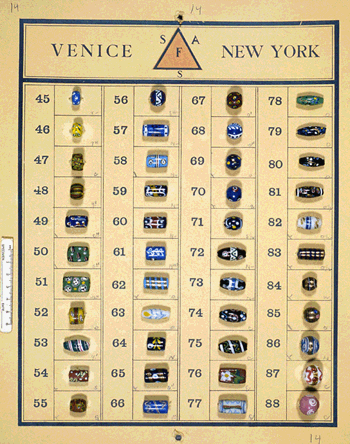


Beads and TradeBeads are small objects, the importance of which in human history is far greater than one might think based on their size. Archaeologists tell us that people have made beads for at least 30,000 years. Although the Illinois State Museum has no beads this ancient, it does have Egyptian faience beads that might be 5000 years old, 3200-year old Egyptian glass beads ca. 1200 B.C., and bone and shell beads from 2000-year old Illinois Hopewellian sites. The Illinois State Museum has thousands of seventeenth and eighteenth century trade beads in its Native American archaeology and anthropology collections. We also have the Frost Trade Bead Collection and several hundred nineteenth and twentieth century beaded objects from Indian groups throughout North America, including objects received by Stephen A. Frost & Son in exchange for beads.
Bead History
The earliest beads are made from natural materials: bone, shell, and stone. Faience - glazed quartzite paste - is the earliest artificial material from which beads are made. It first appeared in Egypt some 5500 years ago, a millennium before the invention of glass. Faience beads were widely traded in the Old World; they show up in archaeological sites throughout the Mediterranean area, in Europe, Africa, and Asia, and notably in India at sites along the Indus River.Ancient peoples adorned themselves with bead jewelry, attached beads in their hair, and buried their dead with beads. Beaded clothing was common, as were baskets, boxes, and other household objects.
In North America, beads made from precious materials such as dentalium shell were used by Northwest Coast Indians to settle disputes. Many Indians in the Eastern Woodlands made purple and white beads from marine shell. Called wampum, these beads were strung together in patterns. Greatly valued, especially by the tribes of the Iroquois Confederacy, wampum strings or "belts" served as symbols of political office, were used to validate agreements and for record-keeping purposes, were given as gifts, and were worn as personal ornamentation. However, despite what you might read in dictionaries and history books, Native Americans did not use wampum as money, though some European colonists - the Dutch and, to a lesser extent, the English - did use wampum they manufactured to pay expenses.
Trading Beads
The first European explorers and colonists gave Native Americans glass and ceramic beads as gifts and used beads for trade with them. The Indians had made bone, shell, and stone beads long before the Europeans arrived in North America, and continued to do so. However, European glass beads, mostly from Venice, some from Holland and, later, from Poland and Czechoslovakia, became popular and sought after by the Indians. The most famous story in American history involving trade beads isn't true. Peter Minuit and his Dutch settlers did not purchase Manhattan Island in 1625 for $24 in beads. As Peter Francis, Jr. demonstrates in a 1986 prize-winning article, "The Beads That Did Not Buy Manhattan Island," the story dates from the nineteenth century and has no historical basis in fact.Europeans, of course, realized early on that beads were important to Native Americans. Corporations such as the Hudson Bay Company and individuals such as Stephen A. Frost developed lucrative bead-trading markets with the Indians (see the section on Stephen A. Frost & Son).
The availability of glass beads increased, their cost decreased, and they became more widely used by Indians throughout North America. Ceramic beads declined in popularity as glass bead manufacturers came to dominate the market because of their variety of color, price, and supply. At first, glass beads supplemented those made from natural materials, but, in time, glass beads almost completely replaced Indian-made ones. For some groups, especially on the coasts, the loss of access to marine shell and the loss of land suitable for hunting to obtain bone led to the eventual predominance of glass beads. Similarly, through time, glass beads largely replaced natural and dyed porcupine quills as decorative materials. One outcome of this was that the quantity of quillwork declined, although it never completely disappeared. The Indians' loss of land and the reduced access to porcupines were also factors in their shift to the use of glass beads.
At the dawn of the twenty-first century, beadwork remains an integral part of some Indian cultures, especially on the Plains and in Western North America. Stores in towns, mail order businesses, and suppliers on the Internet have replaced itinerant bead merchants and trading companies. In an ongoing pattern of innovation, culture change, and continuity among Native Americans, plastic beads are now gaining market share from glass beads, just as glass beads earlier replaced those made from natural materials.
